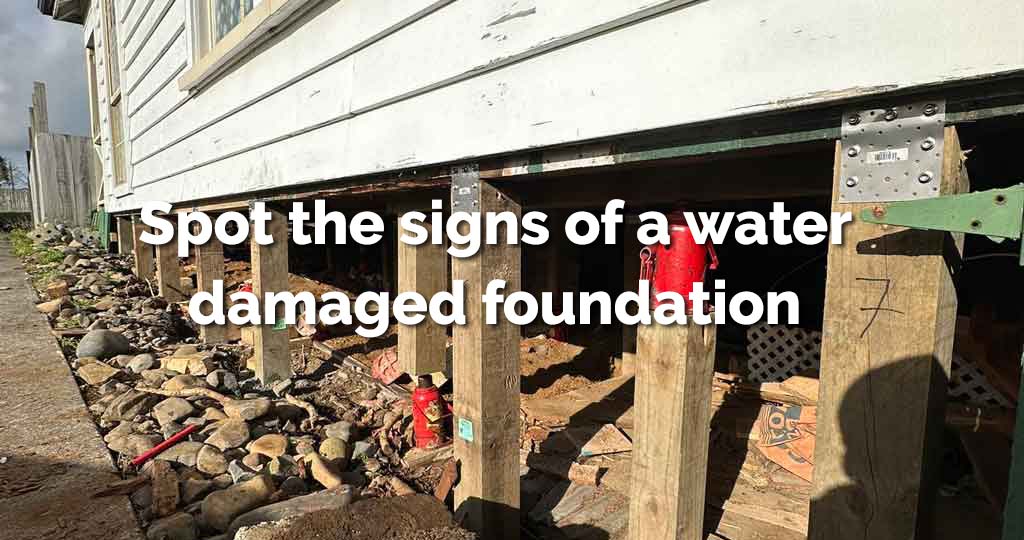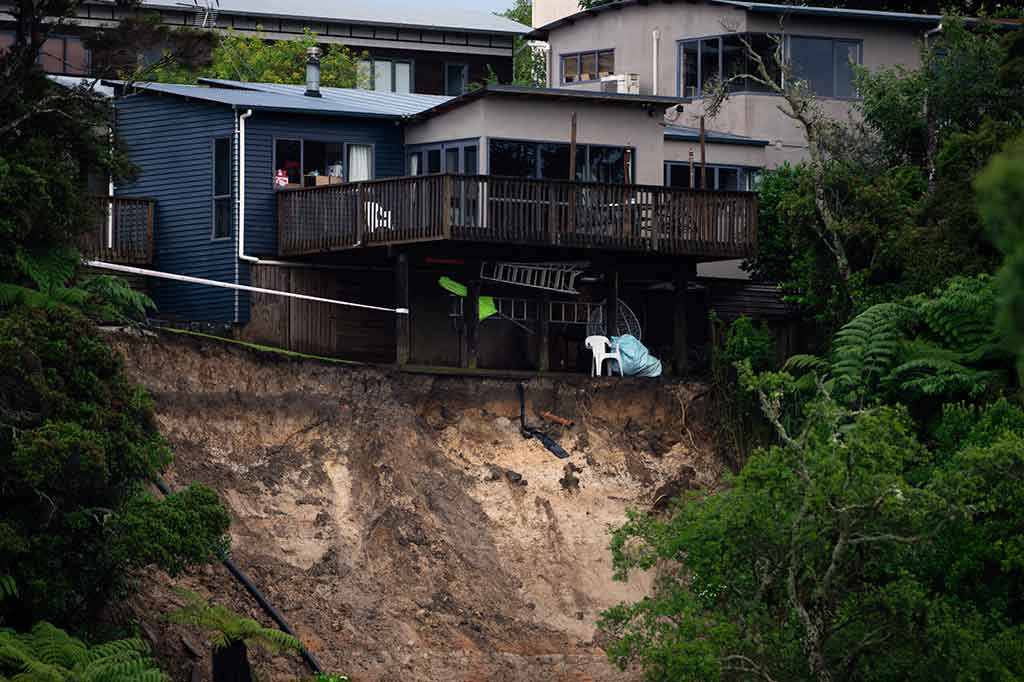
20 Oct Understanding and Spotting Signs of Foundation Water Damage: Tips from a Foundation Repair Expert
Signs of Foundation Water Damage and Preventing Future Water Damage
How Water Damages Foundations and Piles
Water damage to foundations and piles is a pervasive issue that can compromise the structural integrity of buildings. In New Zealand, with its varied climate and topography, structures are susceptible to water-related challenges. Water damage primarily occurs when excess moisture infiltrates the soil surrounding the foundation and piles. This can lead to soil expansion and contraction, resulting in ground movement. Over time, this movement puts pressure on the foundation and piles, leading to cracks, shifts, and potential structural failure. The process is gradual and can be exacerbated by poor drainage systems, proximity to water bodies, or plumbing leaks. Piles, being the deep-rooted supports, are especially vulnerable when the soil around them loses its load-bearing capacity due to saturation. This scenario demands immediate attention as it directly affects the stability of the entire structure.
Signs and Symptoms of Water Damage
Early detection of water damage is crucial to mitigate risks and prevent extensive repairs. Property owners in New Zealand should be vigilant and look out for signs such as:
- Cracks in the foundation walls or floors, which may appear small initially but can widen over time.
- Doors or windows that stick or do not open and close properly, indicating shifts in the structure.
- Uneven or sagging floors, which are a clear sign of foundation movement.
- The presence of mould or mildew, particularly in basements or crawl spaces, is a telltale sign of excess moisture.
- Water pooling around the foundation, which indicates poor drainage and could contribute to further damage.
- Peculiar odours emanating from basements or other lower areas of the structure.
By being observant and proactive, property owners can identify potential issues before they escalate, ensuring the long-term stability and safety of their buildings.
Causes of Water Damage

Common Causes of Water Damage to Foundations
Foundations are critical to the structural integrity of any building, and in New Zealand, they are subjected to various factors that can cause water damage. One of the predominant causes is poor drainage, where water accumulates around the foundation, leading to saturation of the soil and eventual damage. Soil conditions play a significant role as well; different soil types react differently to water exposure. Clay soils, for example, expand when wet and contract when dry, causing ground movement that can damage the foundation. Sandy soils, while facilitating better drainage, can erode over time, leading to instability. Plumbing leaks, whether from internal pipes or external sources, introduce excess water into the ground surrounding the foundation, increasing the risk of damage. Addressing these issues promptly is crucial to maintaining the structural integrity of the building and preventing long-term damage.
The Role of Weather and Climate in Water Damage
New Zealand’s climate varies from subtropical in the north to temperate in the south, with regions experiencing high rainfall, and this diversity in weather patterns significantly impacts water damage risks. In areas with heavy rainfall, inadequate drainage systems can lead to water accumulation and saturation, putting foundations and piles at risk. Coastal regions are susceptible to storm surges and flooding, introducing saltwater, which can be particularly damaging. Conversely, areas prone to drought may experience soil contraction, creating voids that can lead to foundation settlement. Seasonal variations, with wetter winters and drier summers, also play a role, as the soil undergoes cycles of expansion and contraction, potentially damaging foundations over time. Understanding these regional weather patterns and climate conditions is essential in assessing water damage risks and implementing preventative measures to safeguard buildings.
Major Weather Events and the Impact on Foundations of Damage Caused by Water
Over the past year, New Zealand has experienced a series of major storms, resulting in severe weather conditions that have left a lasting impact on buildings and infrastructure. These storms have brought about intense rainfall, strong winds, and flooding, significantly affecting the foundations of houses and commercial structures.
The heavy and persistent rain has led to ground saturation, causing the soil to become unstable and lose its load-bearing capacity. This has resulted in the shifting and settling of foundations, creating cracks and structural weaknesses that compromise the safety and integrity of buildings. In some cases, the floodwaters have eroded the soil around piles and foundations, leaving them exposed and vulnerable to further damage.
Strong winds associated with these storms have toppled trees and debris, causing physical damage to properties and increasing the risk of foundation issues. The aftermath has seen an influx of repair and restoration work, with homeowners and building managers seeking professional help to address the foundation damage and prevent future occurrences.
The recent storms have underscored the need for resilient building practices and effective water management systems to mitigate the risks associated with severe weather events. As a company well-versed in foundation repair, NZ CCS plays a crucial role in helping property owners navigate these challenges, ensuring that homes and buildings remain safe and stable in the face of extreme weather conditions.

Prevention and Mitigation of Foundation Damage
Proactive Measures to Prevent Water Damage
Maintaining the integrity of a building’s foundation is crucial, and there are several proactive steps homeowners can take to protect it from water damage. Regularly checking and repairing gutters and downspouts ensures that rainwater is effectively directed away from the foundation, preventing accumulation. It is also essential to maintain a consistent moisture level around the foundation, avoiding over-saturation during wet seasons and providing supplemental watering during dry periods. Homeowners should also be vigilant about identifying and fixing any plumbing leaks promptly, as these can contribute to soil instability and foundation issues. Conducting regular inspections of the foundation and surrounding areas can help catch potential problems early, while proper sealing and waterproofing of basements and crawl spaces prevent water intrusion. Additionally, ensuring that the property has a proper slope away from the foundation aids in water runoff, reducing the risk of accumulation and damage.
Landscaping and Drainage Solutions
Strategic landscaping and drainage solutions play a crucial role in mitigating water damage risks. Incorporating swales, French drains, or other drainage systems ensures that water is effectively channeled away from the foundation, preventing saturation. Planting vegetation with deep root systems can help stabilise the soil, reducing the risk of erosion and foundation shifts. However, it is vital to plant trees and larger shrubs at a safe distance from the foundation to prevent root systems from causing damage. Proper grading of the property, ensuring a slope away from the foundation, further facilitates water runoff, protecting the building’s structural integrity. By integrating these landscaping and drainage strategies, homeowners create a first line of defence against water damage, safeguarding their properties and ensuring long-term stability.
NZ CCS supports homeowners in implementing these prevention and mitigation strategies, offering expert advice and services to address water damage risks effectively and maintain the integrity of foundations and piles.
Repair and Restoration
Repair Options for Water-Damaged Foundations and Piles
When water damage compromises a building’s foundation or piles, swift and effective repair is crucial to restore stability and prevent further issues. Various repair methods and technologies are employed in the industry to address such challenges. Underpinning is a common technique used to strengthen existing foundations, involving the excavation of soil beneath the foundation and the installation of new supports to bear the structure’s load. Another option is the use of helical piers, which are screwed into stable soil layers to provide support and lift for sagging foundations. For piles affected by water damage, splicing can be used to repair damaged sections, or in more severe cases, entire piles may need to be replaced. Epoxy injections are employed to fill cracks and strengthen weakened areas of the foundation, providing a durable and long-lasting solution. Additionally, waterproofing treatments can be applied to prevent future water ingress and protect the integrity of the foundation and piles.
The Restoration Process: What to Expect
Restoring foundations and piles after water damage involves a comprehensive process to ensure long-term stability and safety. The initial step is a thorough assessment conducted by professionals to determine the extent of the damage and devise an appropriate repair plan. This is followed by the preparation of the site, which may involve excavation and the removal of debris. Once the site is ready, the chosen repair method is implemented, whether it be underpinning, piling repair, or other relevant solutions. Throughout the process, precision and care are paramount to ensure that the repairs are effective and that the structure is adequately supported. After the repairs are complete, waterproofing measures are applied to protect against future water damage, and the site is restored to its original condition. Property owners can expect transparency and professionalism from the repair team, with regular updates and clear communication throughout the process.

Conclusion
Understanding the pervasive and detrimental effects of water damage on foundations is crucial for maintaining the structural integrity of your home. Water-damaged foundations can manifest through visible signs such as foundation cracks, basement wall issues, and other structural damage, all of which demand immediate attention. The concrete foundation, being the bedrock of your home’s stability, is susceptible to damage caused by water infiltrating through cracks and causing erosion.
The signs of foundation water damage are not always overt, and by the time they become noticeable, significant damage may have already occurred. It is essential to keep the area around the foundation dry and ensure proper drainage to prevent water accumulation. Engaging with foundation repair experts like NZ CCS ensures that your property receives a comprehensive evaluation and the necessary repairs to safeguard against future water damage.
NZ CCS is there ready to help, offering expertise and solutions to protect your home from the perils of water damage. Trusting in their knowledge and professionalism guarantees a solid foundation, securing the foundation of your home against future adversities, get in touch with them today if you are concerned that there may be a problem on your home or building.
Key Takeaways
- Regularly inspect for signs of foundation water damage.
- Ensure proper drainage around the foundation to prevent water accumulation.
- Address minor foundation issues promptly to avoid major foundation damage.
- Engage with foundation repair experts like NZ CCS for professional assessments and repairs.
- Implement preventative measures to safeguard against future water damage and maintain your home’s structural integrity.

